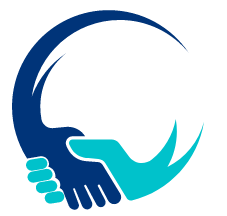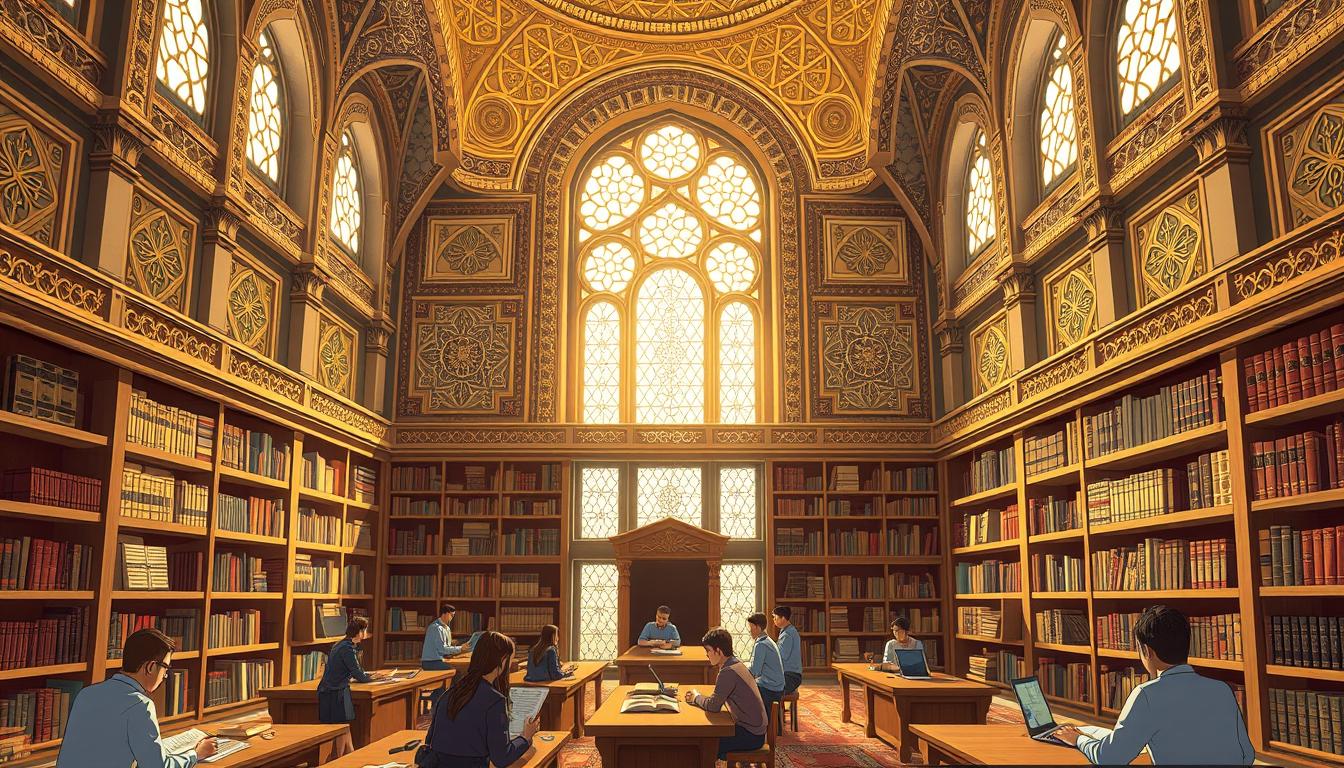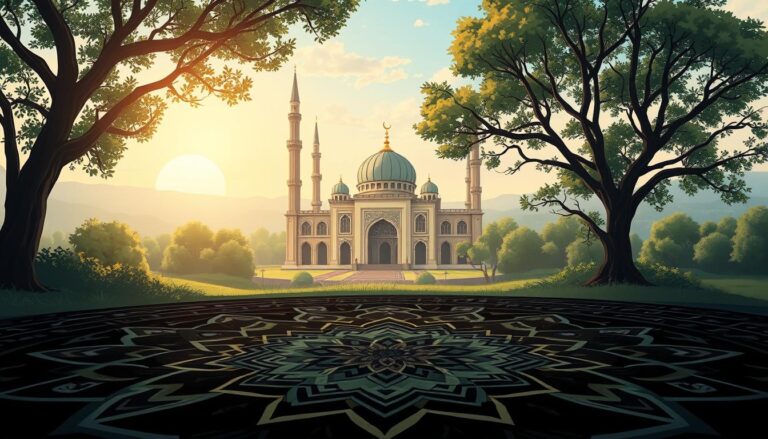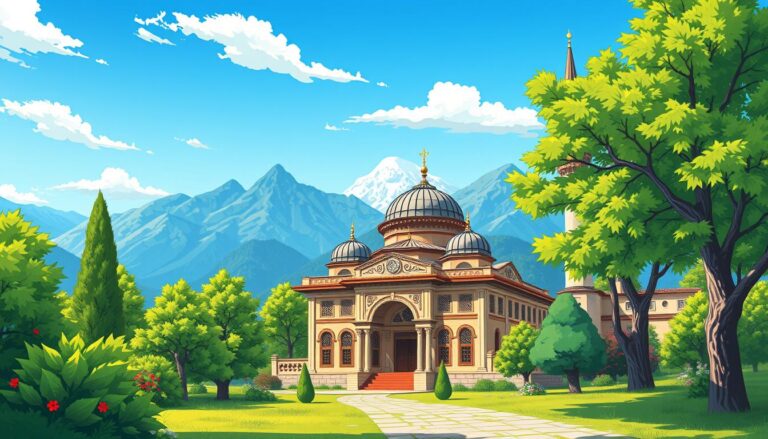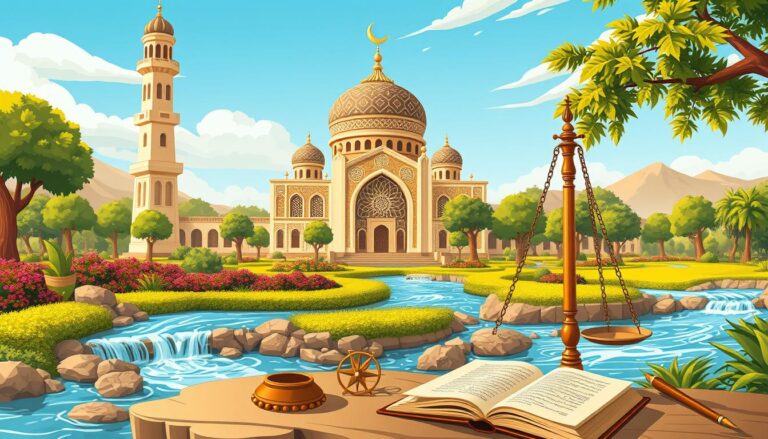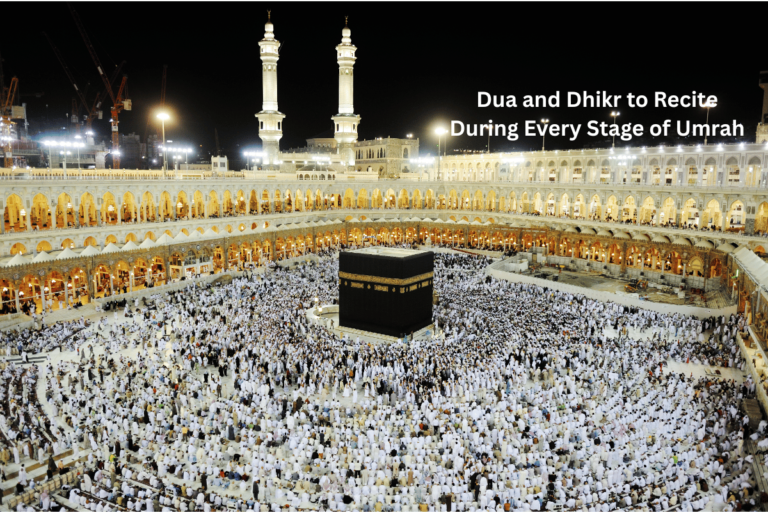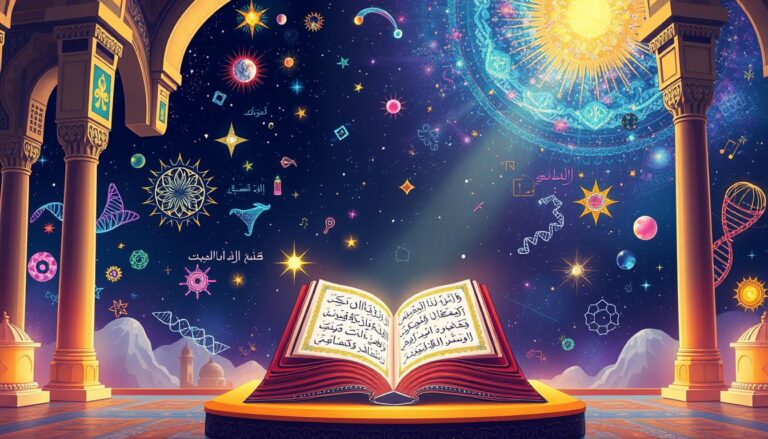The Rich Legacy of Islamic Education and Its Modern Impact
What if the roots of modern science came from an unexpected place? The story of Islamic education is rich and complex. It has shaped our world, from ancient madrasas to modern universities.
In the Islamic Golden Age, from the 7th to 15th centuries, Muslim scholars made huge strides. They discovered new things in medicine, chemistry, and algebra. Their work helped Europe come out of the Dark Ages and led to the Renaissance.
The “1001 Inventions” exhibition highlights these Muslim achievements. It shows the scientific contributions that are often forgotten.
The way Muslims learned was very forward-thinking. Students were taught based on their strengths, not just what they were good at. This led to young geniuses like Ibn Batutta and Ibn Sina, who started their careers early.
Islamic education didn’t split learning into religious and secular parts. It aimed to create citizens who would serve a greater purpose. This approach led to social welfare like free healthcare and education. It focused on caring for God’s creation, unlike many schools today.
Key Takeaways
- Islamic education fostered significant scientific advancements during the Golden Age
- The Muslim approach to education was tailored to individual strengths and learning styles
- Islamic educational institutions produced young prodigies in various fields
- The holistic educational model integrated religious and secular subjects
- Islamic education emphasized social welfare and serving a higher purpose
The Foundation of Islamic Education: Historical Roots
Islamic education began in the early days of Islam. The Quran, Islam’s holy book, talks about knowledge over 800 times. This shows how important learning is in Muslim life. It helped shape Islamic scholarship and early education.
The establishment of Kufa as a center of learning
Kufa became a key place for Islamic knowledge in the 7th century. It was founded by Caliph Umar. Soon, it was filled with hadith scholars and legal experts.
This made Kufa a special place for learning. It helped Islamic education grow.
Abdullah Ibn Mas’ud’s role in shaping early Muslim education
Abdullah Ibn Mas’ud was very important in Kufa’s education. He was sent by Caliph Umar to teach Quran and Islamic law. His teachings started with kids as young as four.
The development of madrasas and universities
As Islamic knowledge grew, schools and universities appeared. Places like Baghdad, Damascus, Cairo, and Cordoba had these centers. They were models for European universities.
Their curriculum covered spiritual, rational, and social development. This aimed to build a balanced person, like Prophet Muhammad.
“Education in Islam seeks to develop human beings in a balanced way, striving to emulate the model of perfection as embodied by Prophet Muhammad.”
This foundation led to the Golden Age of Islam. It was a time of great progress in science, art, and literature. This progress would influence the world for centuries.
Islamic Golden Age: A Beacon of Knowledge
The Islamic Golden Age lasted from the 8th to the 14th century CE. It was a time of great growth in arts, trade, and science. Islamic civilization became a center for cultural exchange and scientific progress, shaping the world for centuries.
Islamic scholars made big strides in many fields. They improved how we observe the world, developed new ideas on the stars, and advanced optics. In math, they introduced algebra, trigonometry, and the Arabic numeral system.
Baghdad and Cordoba were key places for learning. The House of Wisdom in Baghdad was a hub for research and ideas. It had millions of books from different cultures, covering many subjects.
“The quality of translations during this era was exceptional, aiming to incorporate new ideas into ancient works.”
Islamic civilization connected ancient and modern knowledge. Scholars translated and saved texts from Greece, Persia, and India. This helped spread knowledge and advance human culture.
- Advancements in medicine, including surgical techniques and patient care standards
- Development of sophisticated hospital systems and medical education programs
- Contributions to astronomy, with the construction of observatories in Baghdad
The effects of Islamic scientific progress were felt worldwide. The Canon of Medicine by Ibn Sina was published many times in the 15th and 16th centuries. It showed the big impact it had in medicine across cultures.
The House of Wisdom: Baghdad’s Intellectual Hub
The House of Wisdom, or Bayt al-Hikma, was a key place for learning in 8th century Baghdad. It was set up during the Abbasid Caliphate. It became the center of knowledge in the Islamic world.
Translation and Preservation of Ancient Texts
Scholars at Bayt al-Hikma worked hard to translate and save texts from different cultures. They focused on works by Aristotle, Plato, and Hippocrates. They made sure this knowledge was safe for the future.
Advancements in Scientific Fields
The House of Wisdom was a place of big discoveries in many fields. Mathematicians, astronomers, and doctors made new discoveries. They helped start the progress we see in science today.
Cross-cultural Exchange and Dialogue
Bayt al-Hikma was a place where different ideas came together. Scholars from all over talked and shared their knowledge. This helped the Islamic world and others grow.
The Mongol invasion of Baghdad in the 13th century destroyed the House of Wisdom. Many important texts were lost. Now, places like the modern House of Wisdom in Dubai try to keep the spirit of learning alive.
Pioneers of Islamic Education: Scholars and Their Contributions
The Islamic Golden Age was a time of great discovery. Muslim scholars made huge strides in science and medicine. Their work changed the world, from medicine to astronomy.
Ibn Sina, or Avicenna in Europe, wrote the Canon of Medicine. This book was key in teaching medicine for centuries. It covered many areas of medicine, showing the depth of Islamic knowledge.
Al-Razi also made a big impact. He wrote a huge medical encyclopedia. His work on diseases, treatments, and surgery was groundbreaking. He even had special wards for mental health patients.
- Abu al-Qasim al-Zahrawi published a 1,500-page illustrated encyclopedia of surgery
- Al-Khwarizmi, considered the father of algebra, laid the foundation for modern mathematics
- Ibn al-Haytham made groundbreaking advances in optics
These scholars’ work didn’t just stay in the Islamic world. Many texts were translated into Latin and other European languages. For example, Al-Razi’s Treatise on Smallpox and Measles was translated into many languages between the 15th and 19th centuries.
From the 8th to the 11th century, Arabic was the scientific language of mankind, reflecting the profound impact of Muslim scholars on global scientific progress.
The work of these Islamic pioneers still shapes science and medicine today. It shows the lasting impact of Islamic education and scholarship.
The Rich Legacy of Islamic Education and Its Modern Impact
Islamic education has made a lasting impact on the world. It has shaped Western schools and remains crucial in Muslim communities today. Its influence on science and culture is huge.
Influence on Western Educational Institutions
The Islamic legacy helped start modern universities. In 859, Fatima al-Firhi opened the first university in Fez, Morocco. Al-Azhar in Cairo, founded in 970, also played a key role.
These schools introduced new ideas in education. They included practices like ward rounds and free care for the needy. These ideas later became part of Western medicine.
Relevance in Contemporary Muslim Societies
Islamic education is still vital in Muslim communities. It has evolved, adding new subjects and technology while keeping traditional values. This mix keeps it relevant in today’s fast-changing world.
Global Impact on Science and Culture
The influence of Islamic education goes beyond Muslim societies. During the Islamic Golden Age, scholars made big discoveries in math, astronomy, and medicine. Their work helped start modern science and still shapes it today.
- Algebra and algorithms developed by Muslim mathematicians
- Advancements in medicine, including the first hospitals with specialized wards
- Innovations in art and architecture, such as intricate geometric patterns
The “1001 Inventions” exhibition, started in 2008, shows these achievements. It highlights Islamic education’s lasting global impact. This legacy inspires education worldwide, promoting cultural exchange and understanding.
Islamic Education in the Modern Era: Challenges and Adaptations
Islamic education faces big challenges today. The world is changing fast, and old ways of teaching need to change too. Now, Islamic education tries to mix old teachings with new needs.
The Muslim world is changing how it teaches. Many countries are making new rules for schools. They mix religious studies with science and math. This helps students learn for jobs around the world.
But, there’s a big problem. The media often shows a bad side of Islam. This makes people scared of Muslims. Schools are working hard to show the true Islam and fight these wrong ideas.
- Sectarianism within Islam poses another hurdle
- Internal conflicts weaken the collective strength of the Muslim world
- Political instability often stems from sectarian divisions
Islamic schools are teaching students to think and research. They learn to see the world through Islamic eyes. This way, students can handle their faith and the modern world.
“Education is the passport to the future, for tomorrow belongs to those who prepare for it today.”
Islamic education has come a long way, from just studying the Quran to learning many subjects. Today, it keeps changing to stay relevant in our fast-changing world.
Bridging Tradition and Modernity: Reform Movements in Islamic Education
Islamic education is changing. Reform efforts in Muslim societies aim to mix old values with new needs. This change mirrors the evolving Muslim communities around the world.
Integrating Secular Subjects
Today’s Islamic curriculum includes secular subjects. Schools now teach foreign languages, natural sciences, and technology. This helps students compete globally while keeping their Islamic roots strong.
Addressing Global Issues
Islamic education is now tackling global challenges. Students learn about climate change, human rights, and global economics from an Islamic viewpoint. This prepares them to face worldwide issues.
Promoting Critical Thinking
Critical thinking is a big part of reformed Islamic education. Students are taught to question, analyze, and research. This skill matches Islamic traditions of scholarly inquiry and modern education standards.
“Education is the passport to the future, for tomorrow belongs to those who prepare for it today.” – Malcolm X
These changes show a bigger trend in Muslim societies. As communities grow and global communication spreads, Islamic education evolves. The aim is to raise well-rounded individuals who can succeed in today’s world while staying faithful to their beliefs.
The Role of Islamic Education in Fostering Cultural Exchange and Understanding
Islamic education has long been a bridge between cultures. It promotes cross-cultural dialogue and interfaith understanding. This tradition goes back to medieval India, where Islamic rule led to a surge in intellectual activity.
During this time, the number of madrasas and libraries grew a lot. These places focused on a wide range of subjects. They included theology, philosophy, mathematics, medicine, and astronomy.
This approach introduced new disciplines to the region. It laid the groundwork for global citizenship. Islamic education in medieval India offered learning to more people, no matter their social status.
“The integration of Islamic knowledge with existing Indian traditions led to a cultural exchange that enriched various fields, contributing to the development of a unique syncretic culture in India.”
The impact of this educational model is still felt today. Modern Indian education still follows the medieval Islamic period’s framework. It values a balanced curriculum that includes sciences and humanities.
This reflects the values of inclusivity, social justice, and character development found in Islamic education.
- Libraries played a crucial role in preserving and disseminating Islamic knowledge
- Zakat encouraged the wealthy to support education for the less fortunate
- Interaction between Islamic and Indian scholars led to knowledge synthesis
Today, Islamic education continues to promote cultural exchange and interfaith understanding. It helps in developing global citizens who value diverse perspectives and cross-cultural dialogue.
Conclusion: The Enduring Legacy and Future Prospects of Islamic Education
Islamic education has made a lasting impact on how we learn around the world. It has a long history of promoting knowledge and critical thinking. But, it also faces challenges and opportunities in today’s fast-changing world.
Now, Islamic education struggles to stay relevant. Many programs focus too much on religious studies, leaving students unprepared for different careers. This has raised concerns about the quality and usefulness of Islamic education today.
To solve these problems, innovation in education is crucial. Some Islamic schools are adding secular subjects and technology to their curricula. This mix of old values and new skills helps students succeed globally while keeping their cultural roots.
The influence of Islamic education is still strong. It teaches a holistic approach to learning, focusing on both character and knowledge. As education systems worldwide look for balance, Islamic education’s methods could provide important lessons for the future.
Source Links
- 5 Ways Education was better in the Muslim Golden Age – Islamic Self Help
- Islamic world – Reform, Dependency, Recovery | Britannica
- Islam – History of Islamic Education, Aims and Objectives of Islamic Education
- History of Islamic Education
- Islam | Religion, Beliefs, Practices, & Facts | Britannica
- Islamic civilization and its cultural achievements | The Middle Ages Class Notes | Fiveable
- The Golden Age of Ages
- The Air of History Part III: The Golden Age in Arab Islamic Medicine An Introduction
- The House of Wisdom: A Beacon of Knowledge Lost
- House of Wisdom
- Historical Contributions of Muslim Scholars – GlobalSadaqah.com Blog
- Microsoft Word – paper.DOC
- Islam and Education in the Modern Era: Social, Cultural, Political Changes and Responses from Islamic Education
- Contributions of Islamic Civilization to the Modern World
- Islamic Contributions to Global Culture and Civilization
- Challenges Facing Islam, Islamic Civilization, and Muslim Countries
- Islamic Revival and Modernity: The Contemporary Movements and the Historical Paradigms
- Modern Islamic literature | Islamic World Class Notes | Fiveable
- Islam and Modernity: Key Issues and Debates
- The Impact of Islamic Knowledge on Indian Education Systems • Teachers Institute
- Excellence in Islamic Education: Key Issues for the Present Time
- Introduction to Part II: Islamic Education in the Modern Era: Social, Cultural, Political, and Economic Changes and Responses from Islamic Education
